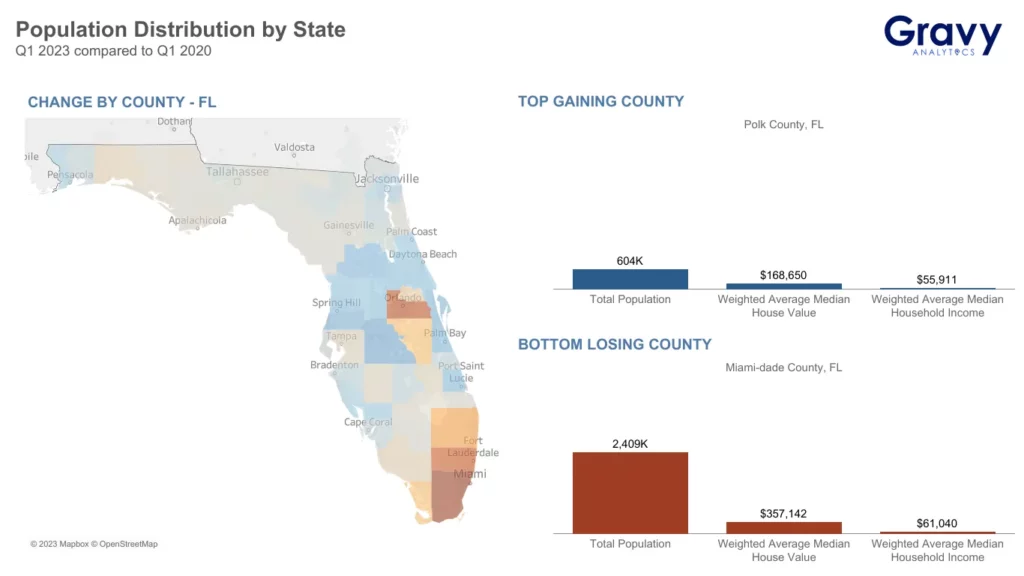What Location Intelligence Can Tell Us About Florida’s Population in 2023
July 27, 2023

Florida is home to Walt Disney World, Universal Studios, and other popular tourist destinations like Miami and Fort Lauderdale. Destinations like these attract hundreds of millions of tourists to Florida each year, boosting consumer foot traffic in Florida and local economies. While most of the tourism in Florida consists of people from other states, we wondered about the details of the population of Florida. So, tourism in Florida has been flourishing, but how has Florida’s population changed in the last few years?

To learn more about Florida’s population movement trends, we examined consumer foot traffic patterns in the state of Florida for our recent population movement report. We augmented that data with U.S. census data about population size, income, and property prices to learn more about why Florida’s population may be shifting and to glean added insights into Florida consumers in 2023.
Florida’s Population Movement Trends
In our study, we analyzed location data signals throughout the state of Florida from Q1 2020 to Q1 2023. We process, cleanse, and prepare billions of location signals daily to ensure high quality, accurate, and privacy-friendly data insights. This allowed us to properly and accurately determine how Florida’s population has shifted since the start of 2020. Here are our findings.
Overall, we found that much of South Florida has experienced population loss in the last few years. When examining location data by county, we determined that Miami-Dade County was the area that lost the most population in Florida for the time period we analyzed. Also seeing some of the greatest population losses in Florida were Fort Lauderdale’s Broward County and Palm Beach County. Some counties farther north in Florida also saw population losses, including Orange County, home of Orlando and Walt Disney World, along with nearby Osceola and Seminole counties.

While some of the most populous and highly visited counties saw the most population losses, many other counties in Florida have gained a fair amount of population. Polk County saw the greatest increase in population in Florida in our study, joined by counties like Marion, Pasco, and Brevard. So, why are Floridians leaving counties like Miami-Dade, and why are counties like Polk County welcoming new residents in recent years?
Florida’s Housing Costs in 2023
Costs of living—particularly housing costs—likely accounted for much of the population shifts seen in Florida in the last few years. In fact, Polk County boasts a median house value that is less than half of Miami-Dade’s $357K. Recently, South Florida’s housing costs rose by 9%, which is almost double the national average of 4.9%. It seems that the rapidly increasing costs of housing in South Florida are affecting population growth and likely affecting consumer foot traffic trends in those areas.
When housing costs increase, rent costs increase, and demand for many consumer goods decreases as consumers allocate more finances to rent payments. Furthermore, high housing costs lead to misallocation of labor as more and more residents become priced out of their neighborhoods, unable to remain in bustling areas with more employment opportunities. Although consumer foot traffic in Florida was on the rise in many place categories after the pandemic, foot traffic to Florida’s commercial places of interest may fluctuate as housing costs impact consumers.
Learn more about how housing costs may have impacted population distribution in other states and counties in our full report.
Other Florida News
Florida was recently named the most popular tourist destination in the U.S. Flourishing tourism is likely fueling economies in Florida, however, Florida’s housing landscape in 2023 may continue to rock its population, forcing more redistribution in the future. Recently, inflation, high premiums, and natural disasters have contributed to an exodus of property insurance companies in the state. This is likely causing obstacles for prospective homebuyers and higher costs for homeowners in Florida, which could have a lasting impact on consumer trends in the state.
Additionally, in 2023, the number of houses sold in Florida is down year-over-year and the amount of time properties spend on the market is up and rising. Could Florida’s housing problems drive Floridians away from the state in the future, or will consumer satisfaction levels continue to draw in more visitors and potential residents?
While Florida is the most sought-after state to move to in the U.S., Florida’s natural disasters, increasing costs of living, or other factors could impact relocation trends and tourism to the state. Furthermore, Florida’s shifting population could impact consumer foot traffic trends to many businesses in the state. It will be interesting to see how Florida’s population evolves and how Florida consumer trends continue to shift.
Our Population Movement Study
These state insights come from our recent report on the current distribution of population across the country, which examined the impact of various factors on population movement trends. Our reliable location data allowed for accurate consumer insights and interesting findings on Florida’s population.
Learning about these population movement patterns over time can help us better understand consumer needs, desires, and preferences. These insights can also help organizations better prepare for any future population movements. By understanding what drives people away from certain locations and what draws them into new ones, researchers can anticipate movement patterns that may impact businesses in the future and maintain a real-world understanding of customer needs. Furthermore, insights like this can inform decisions for site selection, transportation, and even location-based marketing strategy, among many other things.
Download the full State of U.S. Population Movement report today for more information about our methodology, our data, and our findings in this population movement study.




